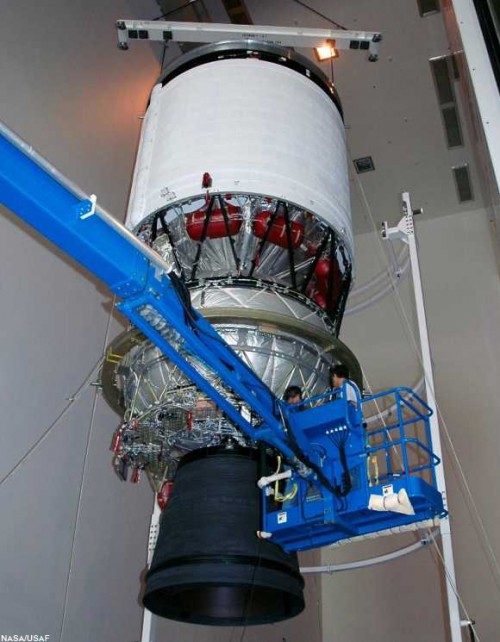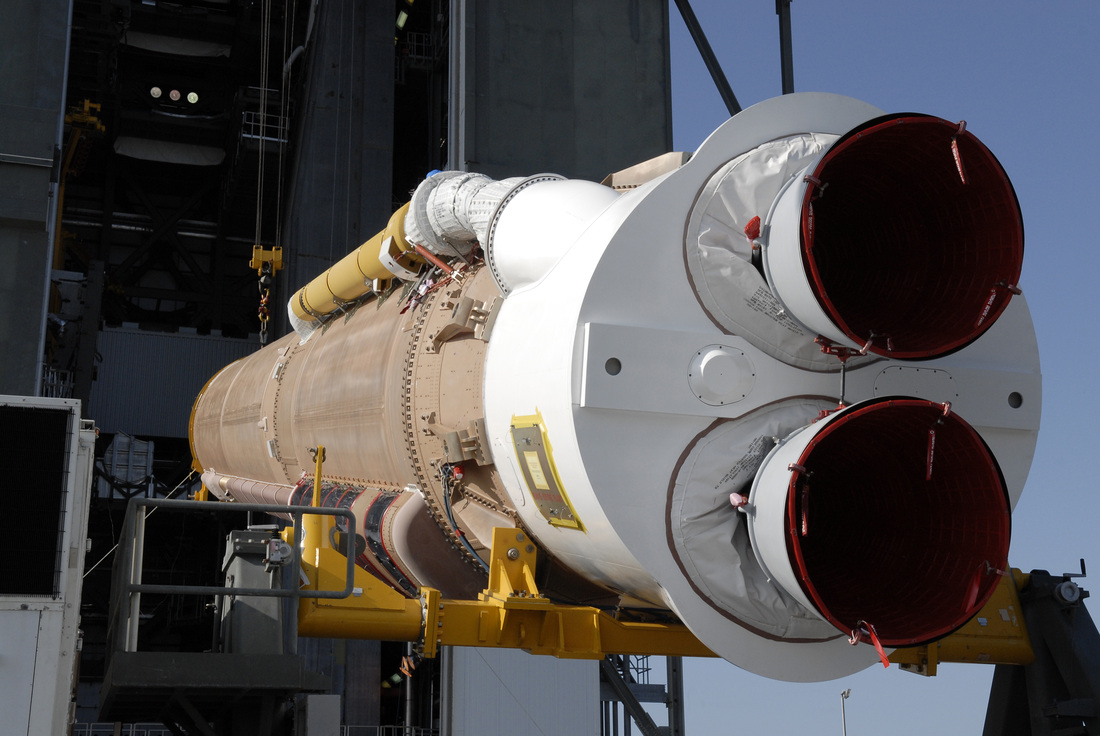
The
United Launch Alliance (ULA) Delta-IV Heavy will be totally phased out
by the BE-4 methane powered Next Generation Launch System (NGLS). Photo
Credit: Mike Killian / AmericaSpace
The NGLS will mark the first major challenge to SpaceX’s reusable Falcon rocket development and could involve the downrange recovery and reuse of engines alone, as opposed to the SpaceX design that uses 30 percent of its propellant load to flyback the entire first stage to the launch site.
The NGLS objective to completely replace the Atlas-V and Delta-IV designs in the coming years is driving the development of three new U.S. liquid rocket engines to serve all the missions envisioned “from LEO to Pluto,” said Tory Bruno, ULA president and chief executive officer.

This
Delta-IV oxygen/hydrogen upper stage will be replaced by a more
powerful and flexible upper stage developed specifically for NGLS
rockets. Photo Credit: NASA / USAF
- The methane/oxygen powered 550,000 lb. thrust BE-4 developed by Blue Origin for replacement of the single Russian RD-180 in the Atlas V. Twin BE-4s will be used in the Atlas.
- A new Aerojet Rocketdyne liquid propellant engine called the AR-1 being developed as a backup to the BE-4 as well as other potential propulsion needs. It will have somewhat less thrust than a BE-4. NASA has contributed about $50 million for this engine development to help reinvigorate the sagging U. S. liquid rocket propulsion development capability.
- ULA is also leading development of the new high energy upper stage to replace the RL-10 oxygen/hydrogen line pioneered in the 1960s.
ULA has been keeping major design aspects of its NGLS secret in order to make a big news splash at the symposium. However, at a recent (but little noticed) presentation to the Stanford University Student Space Initiative, Bruno discussed at length reusable rocket NGLS engineering tradeoffs, but declined to specifically say how they applied to the new rockets.
Bruno raised the reusability question, then answered himself by saying, “I’m not going to share the architecture of the Next Generation Launch System [here at Stanford ] so there will be no spoilers tonight—ahead of the Colorado Springs symposium,” he said. “But but what I would like to do is talk about the systems engineering in general for reusability.”
He said with NGLS he is “feeling a tremendous sense of optimism and excitement about our future . We are on the threshold of a huge adventure.”
“We need to make space more accessible for that great journey that you and I are at right now, so I am transforming our company. We have cut the price of launch in half and I will do it again with the NGLS, and I will do the same for the cycle time for launches,” Bruno said at Stanford. “We will introduce a new rocket and an entirely new and unprecedented way about purchasing those rockets.”
“We are going to make space so much more accessible than it ever has been before,” he said. The current cost of an Atlas-V launch is $164 million, while a Delta-IV Heavy costs $389 million.

Each
Atlas V is powered by a single oxygen/kerosene Russian RD-180 with two
engine nozzles. By 2019 ULA hopes to instead power the launcher with two
BE-4 methane/oxygen engines. Photo Credit: NASA / ULA
A single RD-180 engine with twin nozzles is used in each Atlas V.
Bruno appeared last week before the House Armed Services Subcommittee on Strategic Forces urging the lawmakers not to halt access to the RD-180s until he has time to get the NGLS underway.
“The current narrow interpretation of the Defense Authorization bill could preclude ULA from receiving previously ordered engines, which means the Air Force would only have one provider. Not only is that anti-competitive, it puts the Air Force national security mission requirements at risk,” he told the subcommittee.
The new launch system is expected to produce its first flight in 2019, with full certification in 2022-2023.
“If the RD-180 is prematurely cut off before a new engine and vehicle is certified, there will be no other launch provider who can perform the full range of launch capabilities currently required under the law,” Bruno said, referring to Assured Access to Space, which requires that the nation maintain two launch vehicles at all times to support the nation’s launch requirements.
While ULA is preparing for its major unveiling of the NGLS, it has just received a $389.1 million NASA launch contract for the historic Solar Probe Plus (SPP) mission set for launch in July 2018 on a Delta-IV Heavy from Cape Canaveral, Fla.
SPP will be the first mission to fly through the Sun’s outer atmosphere—the solar corona—to examine two fundamental aspects of solar physics: why the corona is so much hotter than the Sun’s surface, and what accelerates the solar wind that affects Earth and our Solar System. Understanding these fundamental phenomena has been a top-priority science goal for more than five decades. SPP will orbit the Sun 24 times, closing to within 3.9 million miles of its surface with the help of seven Venus flybys.